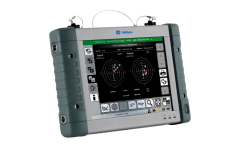
Rotortuner RT-Balancer
The Rotortuner Balancer (RT-Balancer) is a portable or semi-permanently installed Propeller Balance and Vibration Analysis system for use on fixed-wing propeller aircraft.
Description
Comprehensive balance solutions, unique advanced vibration analysis capabilities, and a user-friendly interface make the RT-Balancer the engineer’s favourite propeller balancing equipment.
The Rotortuner Balancer is fully compliant with the appropriate sections of Mil.Std.810E, DIN 40 050 IP44 and RTCA DO-160C.
System control
Overall control of the RT Balancer is through an ergonomically designed Hand-held System Controller (HHSC) with a touch-sensitive membrane over a high-resolution backlit LCD display. It is robust and easily readable making it ideally suited to the demands of the flight deck or cockpit environment, and is powered by the Data Collection Unit. All data and solutions may be viewed in flight and hard copies obtained from the integral printer. The unit currently supports two user-selectable languages; English, and German.
Data input and storage
Data from up to 8 accelerometers and 4 tachometer channels are integrated into the Data Collection Unit to provide data viewable as polar balance plots and frequency domain vibration signatures. All data is stored on a removable PCMCIA card which is used for data transfer and subsequent detailed off-line analysis in the RT Vision Ground Support Station.
Data analysis
The capabilities of the RT Balancer are determined by the Firmware currently installed, a full description of which may be found in the Firmware Data Sheet. In general, the system will collect balance data from up to 8 different flight conditions and supply balance solutions according to the operator's requirements, a range of vibration signatures up to 1000 Hz and 6400 lines resolution are available with at least one range covering the 1 x P and N x P frequencies. Other ‘windowed’ ranges may be configured to extract and highlight frequencies of special interest for specific aircraft diagnostic requirements.
Firmware upgrade options
The system is designed so that future improvements and upgrades to the functionality of the overall system, as well as refinements to aircraft information, may be incorporated through the use of Firmware Upgrade Cards or Aircraft Data Cards supplied on PCMCIA cards.
Customer support
The team members are experienced aircraft engineers with a wealth of experience in aviation maintenance specialising in Rotor Track & Balancing of dynamic components as well as propeller balancing, and Vibration Analysis. We can be contacted directly by telephone, fax, email, or through the website. Helitune promotes a personal service and is happy to create customised configurations to suit special requirements.
Product Specification
Performance Data | |
| Sensor Inputs | Up to 8 accelerometers, 4 reference |
| Frequency Ranges | Up to 1000 Hz in windowed ranges set to suit specific aircraft and operator requirements. |
| FFT Analysis | Up to 6400 lines resolution |
Electrical Specification | |
| Connectors | MIL C 38999 Series III |
| Power Supply | 21 – 32V DC at 4 Amp maximum. Protected against over-voltage, reverse polarity and power loss. Max. power consumption 100W |
Physical Specification | |
Data Collection Unit | |
| Dimensions | 150 mm x 230 mm x 320 mm (361mm with front and rear handles) |
| Weight | 4.8 Kg |
| Operating Temperature | -20 to +55 degrees Celsius |
Hand Held Terminal | |
| Dimensions | 70 mm x 147 mm x 273 mm |
| Weight | 1.25 Kg |
| Operating Temperature | -20 to +55 degrees Celsius |
Data Collection Accuracy | |
| Vibration | +/- 0.2% of scale range |





